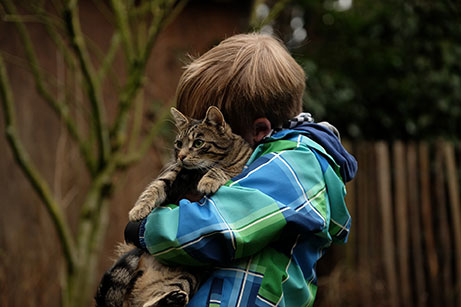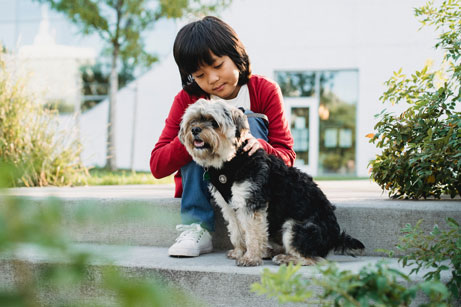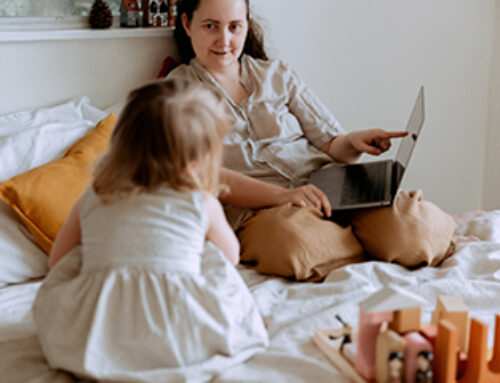Many people are spending significantly more time at home and there has been a recent spike in new pet owners. What better way to spend time at home than with a furry friend? Having a pet can break up the mundane day-to-day, provide additional structure to your day, and help teach responsibility while caring for another if done in the right way. There is also some interesting research supporting the benefits of the inclusion of pets during play to help children with Autism Spectrum Disorder feel supported and decrease anxiety in social situations. (Check them out here, here, and here if interested!). Many neurodiverse children experience anxiety, and bonding with an animal can be a great way to combat that stress.
On the other hand, while there are many benefits to getting a pet, it is a big change. Our kids are already dealing with a lot of uncertainty and upheaval, and adding in caring for a pet may be more stressful than it’s worth. If you are interested in adding a furry family member to the mix for the first time, check out the tips below to promote safety and success!
Preparation
This can be done in a number of ways. Utilize strategies you have successfully implemented to help your child cope with change in the past, such as a social story or video of another child playing safely with a pet. Talking about the pet and showing pictures is a great way to provide your child with a preview of what is to come. Create rules or guidelines prior to pet interactions to promote successful initial interaction. Depending on your child’s preferred method of communication, you can incorporate visual or verbal reminders to review prior to interaction with your pets.
Environmental Set-Up
Use your environment to help provide visual reminders of the upcoming change and additional housemate. Have your child help make changes to the living space, identify where the pet will sleep and eat, and where it will keep its toys. Allowing your child to be part of the process can help increase their sense of control and increase positive feelings towards your pet prior to its arrival.
Previewing
If possible, spend time with some different pets prior to making your decision. This can be a great way to practice your pre-determined rules and to test out if you and your child are ready for a pet. Some children do not yet have the safety awareness or body awareness of themselves or others and may need to look into a specific type of pet to best meet their needs. Testing this out in a low-risk situation can help you and your child determine how best to support your own leap into pet ownership.

So you’ve decided to get a pet! You’ve tested, prepped, and created the perfect environment. How do you best set up your child to create a loving relationship with your new pet?
Below are some tips to facilitate safety and trust between your child and pet.
- Provide movement opportunities and regulating input prior to interacting with the pet. Proprioceptive input or heavy work are great ways to “warm-up” prior to play. This can include big hugs, rides on the blanket on their belly, facilitated jumps, pulling their sibling in a blanket or wagon, wheelbarrow walks, or squeezes/ joint compressions. This will help your child obtain a calm, alert state prior to interacting with the pet.
- Set clear rules/expectations prior to interaction. Use concrete rules, keep track, and enforce them, no matter your child’s reaction. This will help set boundaries and expectations with your pet and will help build trust between your child and pet.
- Begin with structured, supervised interactions lasting for limited intervals. Start with a short time (1-2 minutes), making it clear before you begin how long you will be playing with the pet. Use of a visual timer or a timer on your phone with the auditory cue can help create an easy transition. Use of an exciting toy or activity following the transition from a pet will help ease the transition and provide a preview of what is to come next.
- Clearly state how your child can stop play with your pet if they are nervous or uncomfortable. Offer verbal reminders of this if your notice your child is showing signs of dysregulation or overstimulation.
- Model how to interact with the pets, giving specific examples (I.e. “You can pet their ears like this!”). Point out how to tell when the pet is happy (purring, tail wagging) and when the pet seems upset (running away, hiding, nipping, etc).

- Be sure to provide praise for positive interactions, even if you feel you are praising the same thing over and over again. Depending on your child, you may need to provide consistent signs of encouragement (smiling and nodding) or less frequent praise (every 2-3 minutes).
- Narrate what the pet is doing and how it makes you feel, especially if your child seems nervous. Many of our kids benefit from additional time to process visual input or changes within the environment, so having an adult talk them through what is happening can promote feelings of calm and ease.
- If your child needs additional support to engage successfully with your pet, using a reward system or token board can be a way to teach your expectations and set your child up to succeed. “If you are able to be safe with the cats for 3 minutes, you get ____.” It does not always need to be a tangible item. It can be something like “a massive bear hug!” or “10 big kisses.” You can use the visual token board for this if you feel comfortable. The use of visuals can help promote understanding and visual reminders, increasing impulse control.
Your child may require a different level of support than what is represented in this article, so it’s best to reach out to your providers for additional tips and tricks specific to your child’s individual needs.
Feel free to mix and match ideas and utilize what works best for you and your family!

Blue Bird Day fosters socialization, sensory regulation, and pre-academic learning in children ages 2-7 years in therapeutic rotations that simulate preschool and kindergarten settings. Our compassionate therapists practice a relationship-based and family-centered approach, provide parent training, and collaborate on goals and individualized intensive treatment plans for your child.
We believe in a collaborative and multi-disciplinary team approach to therapy. A team of occupational therapists, speech-language pathologists, dietitians, developmental therapists, behavioral therapists, physical therapists, and therapeutic assistants are created for each child to ensure child and family are fully supported and the best possible results are achieved.
Options for individualized, group and virtual therapy sessions are available as well.
Want to learn more or you have a specific question? Feel free to connect with us here!



